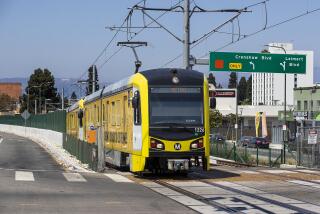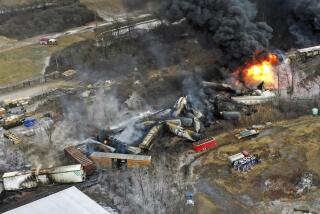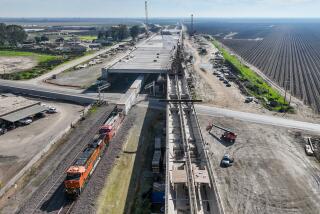Ending Deadly Rail Encounters Will Be Costly : Transit: Agency will seek $736 million to eliminate 92 street-level track crossings along San Diego-Los Angeles Amtrak route.
In the wake of recent train-related deaths, including two in Del Mar fourdays ago, the agency overseeing passenger service between San Diego and Los Angeles will seek federal funds to elevate or lower the tracks at 92 street-level crossings--roughly half of which are in San Diego County.
The ambitious, $736-million project is expected to take 10 to 20 years to complete and would achieve its goals through “grade separation,” meaning pedestrians and drivers would not connect with the railway at any crossing point along the 128 miles of tracks. The trains either would run on elevated tracks that pass over cars, or in underpasses beneath the road.
“It would work just like a freeway,” said Arthur Lloyd, the state spokesman for Amtrak. “A freeway doesn’t have signal lights and intersections, and this wouldn’t either.”
The program also would involve greater enforcement of no-trespassing regulations, more comprehensive warning signs and a media education blitz to prevent further tragedies.
Approval for a resolution supporting the project is expected Wednesday at a meeting of the Los Angeles-San Diego Rail Corridor Agency, or LOSSAN, said Sharon Greene, its executive director.
“There have been more incidents than we ever anticipated,” Greene said from her office in Orange County. “Safety projects have to be made a priority.”
According to rail officials, a set-up like this would have prevented the Wednesday death of La Jolla clothing designer Usha Waney, 47, who was killed as she attempted to cross over an uneven path of gravel, rails and wooden ties while making her way from a parking lot to the Amtrak depot in Del Mar.
Waney was hit by an oncoming freight train that she apparently thought was the Amtrak passenger she was trying to catch. In the seconds before the impact, Roberta Halpern, 44, and her husband, Lee Kaiser, 36, tried to pull Waney off the tracks.
Halpern, a cancer researcher from Encinitas, was also hit by the train and died several hours later at a La Jolla hospital.
In the wake of the accident, the two women’s families as well as commuters said the station needs signs, or a fence, or some other construction to prevent such accidents.
Amtrak spokesman Lloyd said Friday, however, that he wasn’t sure warning signs or fences are necessary, since commuters such as Waney and Halpern were, in essence, “trespassers.”
“You mean those trespasser accidents?” he said, referring to Wednesday’s tragedy. “Those people trespassed on a railroad right of way. They were not crossing at a legal crossing. I don’t think warning signs are necessary, since, if you can’t read, you can’t read.”
Asked what he meant, Lloyd said he was referring to another train-related death in San Diego County, in which the victim couldn’t read.
“Those people Wednesday (Waney and Halpern) were crossing over an illegal pathway, so what are you going to do--put up signs every 2 feet?” Lloyd said from his office in San Francisco. “Those people died of their own volition. You just don’t cross railroad tracks at unspecified railroad crossings.
“Would you run across a runway at Lindbergh Field? It’s regrettable that such things happen, but there’s not much you can do about human stupidity.”
Sharon Greene of the Los Angeles-San Diego Rail Corridor Agency took a more compassionate position, saying she was concerned over a series of accidents that have claimed six lives in the last three months alone in San Diego County.
In October, four people died on so-called corridor tracks, just in San Diego County.
On Oct. 5, a Carlsbad grocery clerk was killed by an Amtrak train as he carried a bicycle along a trestle near Basilone Road in the North County.
On Oct. 13, a woman was struck in Encinitas by another passenger train as she sat on the tracks smoking a cigarette.
Eight days later, two migrant workers were killed by an Amtrak train in Leucadia as they reportedly sat on the tracks playing cards.
Despite the fatalities and growing public concern over them, the San Diego County Task Force on Railroad Safety concluded at a recent meeting that train-related accidents in the county were “low and perhaps below other similar corridors,” said James Larson, who covered the meeting for the California Department of Transportation. (Caltrans requested the session, which was held at the Padre Trail Inn in San Diego on Oct. 31.)
“It was explained that railroad corridors are very dangerous, and people do not belong on or near the tracks,” Larson wrote in his report. “The corridor often attracts transients, immigrants, surfers, and, in some cases, young people gathering to party.”
He quoted Bill McGinn of Santa Fe Railway, which owns the lines, as saying that “there are many people in the railroad right of way.”
In searching for ways to improve safety, Larson noted that the city of Solana Beach has responded to the “transient” issue by removing shrubbery, banning alcohol consumption and beefing up police enforcement along the corridor.
Larson added that fencing along the tracks was discussed but not thought to be the answer “in a general sense.” He noted that some communities are adamantly opposed to fencing.
Thinking long-term, Amtrak’s Lloyd said grade separation is “the far more effective method,” albeit with a major drawback: “It’s outrageously expensive.” He said the method had worked “beautifully” in Alhambra, Calif., and El Paso, Tex., cities that recently devoted the capital expenditure necessary to make it work.
“You have to get outside funds for it--whether it’s city, state or federal--because the railway companies just don’t have the money,” Lloyd said. “But it does work.”
Lloyd said it gives the railway line more of a streamlined, “21st-Century” look and is revolutionary only in the sense that it’s new.
In the meantime, other officials see public education as the best guarantor of safety. In recent years, train-related injuries and deaths have shown a sharp increase statewide.
Rail officials say 34 pedestrians were killed and 63 people injured by trains statewide in 1989. Another 44 motorists died, and 100 more were injured in California accidents involving automobiles and trains.
In Orange County, two men were killed in separate incidents in November--one by an Amtrak train that clipped the construction lift he was working on near the tracks, and the other as he walked across the tracks in front of another Amtrak train.
LOSSAN’s Greene said the plan to separate rail service from other traffic at street level also is intended to increase train speeds and avoid interfering with the public’s use of the roads, thus improving traffic flow in local communities. But she added that improving safety is the major benefit.
“The reason we want to do this involves a combination of speed, safety and compatibility with the community,” she said.
Passage of Wednesday’s resolution, said Greene, is expected to launch an intense lobbying effort in Sacramento and Washington, to secure the federal funds.
Through the state Public Utilities Commission, officials said, a maximum of $15 million a year is spent on grade separation, with no single project eligible to receive more than $5 million in one year. The separations cost about $8 million each.
Greene said a chance to secure more federal funding is approaching, as U.S. transportation programs are scheduled for a major review in Congress by September, 1991. The U.S. Department of Transportation has proposed selection of three “demonstration” corridors, with federal funds to total $1 billion over four years.
There are now only a handful of grade separations along the LOSSAN corridor, such as Highland Avenue in Fullerton and State College Boulevard in Anaheim.
Greene said it’s merely a coincidence that the rail safety task force findings are being submitted at the same time as the resolution favoring grade separations.
Greene headed the task force, which has already scheduled an “Operation Lifesaver” speakers training program that will blitz communities with educational materials about train safety.
The task force is also developing an international symbol for use in a new sign program to reduce trespassing and notified 911 dispatchers of appropriate emergency telephone numbers for the railroads.
Moreover, the Rail Safety Awareness Task Force asked local law enforcement agencies to increase enforcement against trespassing along the corridor.
Few agencies fence off their rights of way, and if they do, it’s mostly near stations, according to a survey.
The first “community blitz” educational effort is scheduled Thursday in Encinitas.
More to Read
Sign up for Essential California
The most important California stories and recommendations in your inbox every morning.
You may occasionally receive promotional content from the Los Angeles Times.









